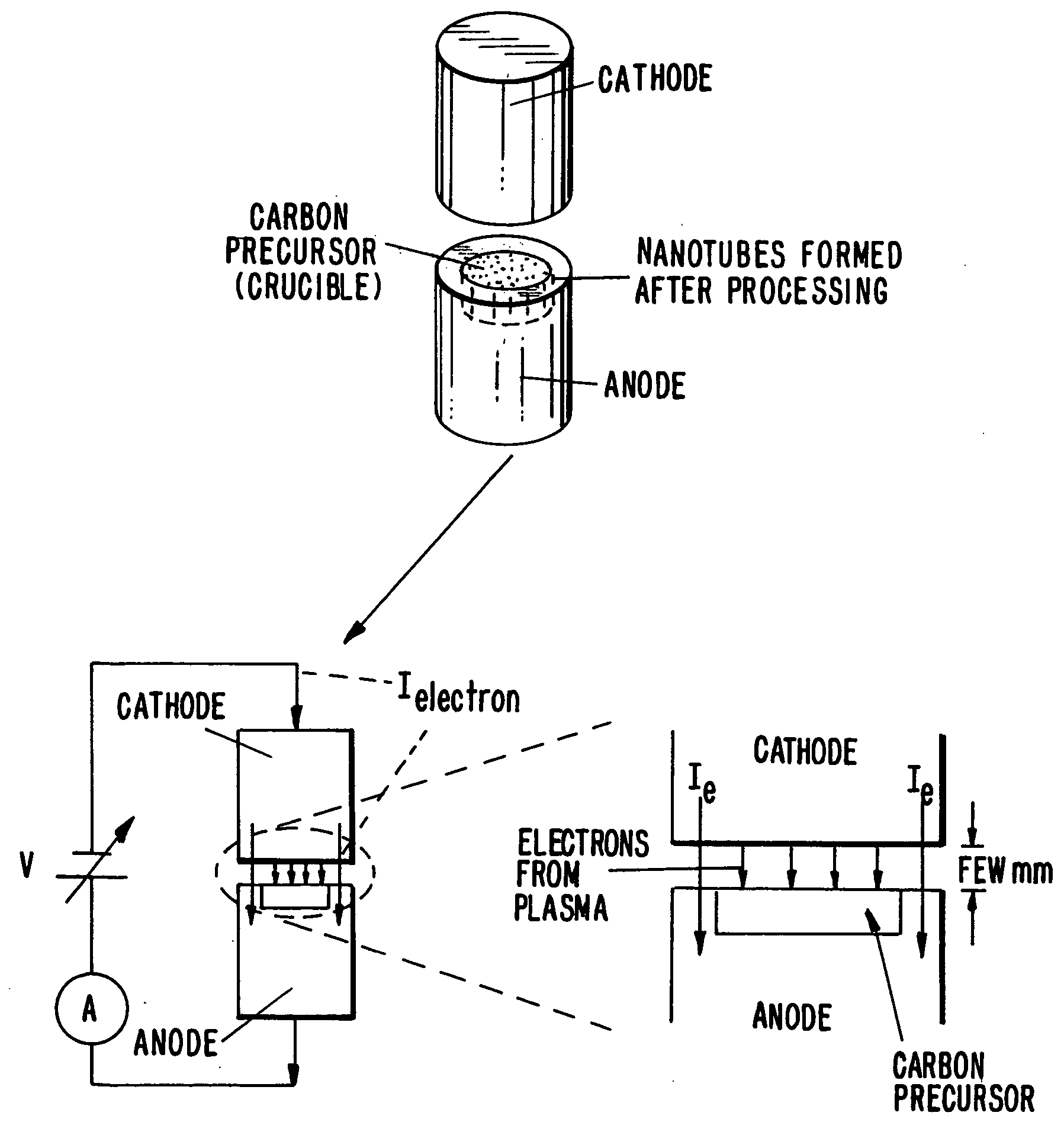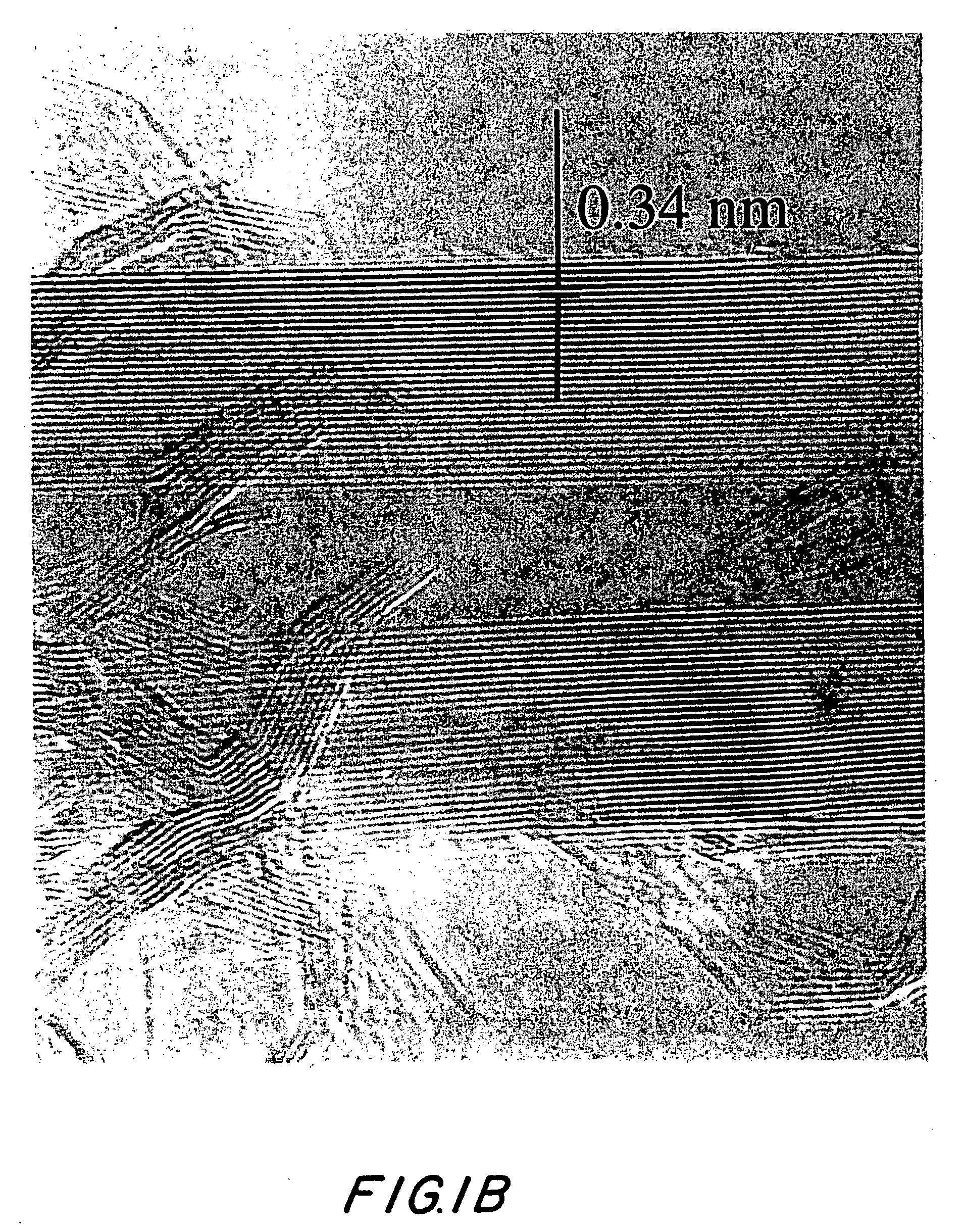Carbon nanostructures and methods of preparation
a carbon nanotube and nanostructure technology, applied in the field of carbon nanotubes and methods of preparation, can solve the problems of short (100 nm) nanotubes, defects in carbon nanotubes, and conventional methods of making multi-walled nanotubes via arc discharg
- Summary
- Abstract
- Description
- Claims
- Application Information
AI Technical Summary
Benefits of technology
Problems solved by technology
Method used
Image
Examples
example 1
[0066] Fullerene soot was made by the arc evaporation of graphite at 450 Torr of He, then activated in a flowing CO.sub.2 atmosphere at 850.degree. C., which increased its surface area. The soot was then mixed with varying amounts (0-20 wt %) of amorphous boron and annealed under flowing He in a graphite resistance furnace to 2200-2400.degree. C. Boron was added to accelerate the assembly of fullerene soot by acting as a fast diffuser in the basal planes of graphite. Annealing fullerene soot without boron provided polyhedral carbon particles as in previous experiments. In comparison, analysis of the annealed fullerene soot mixed with boron showed nanotubes with length much longer than 0.5 .mu.m (FIG. 1A).
example 2
[0067] High resolution micrographs (FIGS. 1B and 1C) show that the tubes of example 1 made using boron were similar to multiwalled nanotubes made using an arc discharge, with occasional kinks in the nanotube (FIG. 1C). However, some nanotube ends were not completely closed and had disordered carbon around the tip (FIG. 1B). The disordered carbon at the tip indicates that growth was frozen either when the furnace was cooling or when the local carbon supply was exhausted. The inner shells of nanotubes were occasionally closed off, as in some nanotubes produced in an arc discharge (FIG. 1C). Polyhedral graphitic nanoparticles were the majority of the products (FIG. 1A).
example 3
[0068] The applicability of this invention was extended to other disordered carbon materials: for example, ball milled graphite and sucrose carbon. While heat treatment of ball milled graphite with boron (FIG. 2) did not produce any nanotubes (only bent and tangled graphitic sheets and closed particles are found), annealing sucrose carbon with boron does produced multiwalled carbon nanotubes (FIG. 3). Open nanotubes were also seen in these experiments (FIG. 3A). The overall yield of nanotubes when annealing sucrose carbon was low. These experiments show that it is possible to make nanotubes by controlling the heat treatment of common and inexpensive organic materials. Also, some nanotubes might be attached to graphitic particles as shown in FIG. 3B. These larger graphitic particles might act as nucleation sites for nanotubes. However, if this were the case, every heat treatment sample should have nanotubes because after heat treatment all samples had similar graphitic particles. Con...
PUM
| Property | Measurement | Unit |
|---|---|---|
| temperatures | aaaaa | aaaaa |
| lengths | aaaaa | aaaaa |
| length | aaaaa | aaaaa |
Abstract
Description
Claims
Application Information
 Login to View More
Login to View More - R&D
- Intellectual Property
- Life Sciences
- Materials
- Tech Scout
- Unparalleled Data Quality
- Higher Quality Content
- 60% Fewer Hallucinations
Browse by: Latest US Patents, China's latest patents, Technical Efficacy Thesaurus, Application Domain, Technology Topic, Popular Technical Reports.
© 2025 PatSnap. All rights reserved.Legal|Privacy policy|Modern Slavery Act Transparency Statement|Sitemap|About US| Contact US: help@patsnap.com



